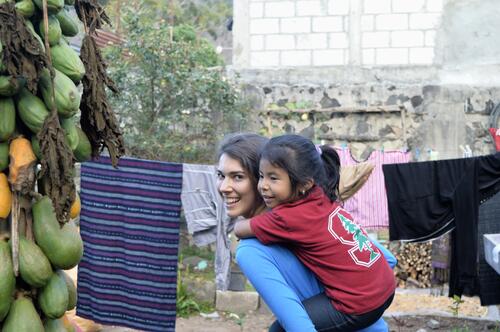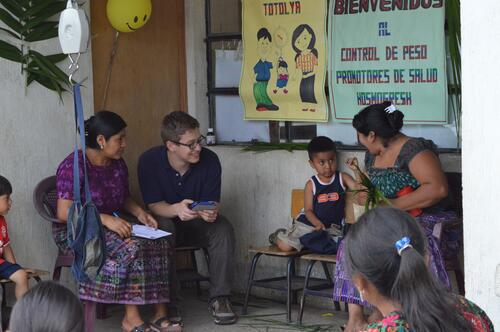SHP-led study shows U.S. Feed the Future program reduces stunting of children in Africa
The U.S. government's global hunger and food security initiative, Feed the Future, has prevented 2.2 million children from experiencing malnutrition in sub-Saharan Africa, according to new research led by Stanford Health Policy's PhD candidate Tess Ryckman.
The researchers compared children’s health in 33 low- and middle-income countries in sub-Saharan Africa. In 12 of those countries, Feed the Future provided services such as agricultural assistance and financial services for farmers, as well as direct nutrition support, such as nutrient supplementation.
The study, published online Dec. 11 in The BMJ, found a 3.9 percentage point decrease in chronic malnutrition among children served by Feed the Future, leading to 2.2 million fewer children whose development has been harmed by malnourishment.
“What we see with stunting rates is striking,” Ryckman said. “I would argue that 2 million fewer children stunted over seven years is major progress and puts a substantial dent in total stunting levels. And that’s 2 million children who will now have the levels of physical and cognitive development to allow them to reach their full potential.”
Stunting, or having a low height for a particular age, is a key indicator of child malnutrition. Children who aren’t properly nourished in their first 1,000 days are more likely to get sick more often, to perform poorly in school, grow up to be economically disadvantaged and suffer from chronic diseases, according to the World Health Organization.
A Controlled Study
Feed the Future is thought to be the world’s largest agricultural and nutrition program, with around $6 billion in funding from USAID (plus more from other federal agencies) between 2010 and 2015. Despite its size, much remains unknown about the effectiveness of the program.
The researchers analyzed survey data on almost 900,000 children younger than 5 in sub-Saharan Africa from 2000 to 2017. They compared children from the Feed the Future countries with those in countries that are not participants in the program, both before and after the program’s implementation in 2011.
The researchers found the results were even more pronounced — a 4.6 percentage point decline in stunting — when they restricted their sample to populations most likely to have been reached by program. These included children who were younger when the program began, rural areas where Feed the Future operated more intensively, and in countries where the program had greater geographic coverage.
“Our findings are certainly encouraging because it has been difficult for other programs and interventions to demonstrate impact on stunting, and this program has received a lot of funding, so it’s good to see that it’s having an impact,” Ryckman said.
Multifaceted Approach to Nutrition
Experts are divided about the best way to help the world’s 149 million malnourished children: Is assistance that directly targets nutrition, such as breastfeeding promotion or nutrient supplementation, more effective? Or is it also beneficial to tackle the problem at its root by supporting agriculture and confronting household poverty?
The authors, including Stanford Health Policy’s Eran Bendavid, MD, associate professor of medicine, and Jay Bhattacharya, MD, PhD, professor of medicine, a senior fellow (by courtesy) at the Freeman Spogli Institute of International Studies and a senior fellow senior fellow at the Stanford Institute for Economic Policy Research, said their analysis supports the value of a multifaceted approach to combating malnutrition among children, namely leveraging agriculture and food security interventions.
“Independent evaluations of large health policy programs such as Feed the Future help build the evidence base needed to tackle persistent patterns of undernutrition,” said Bendavid, an epidemiologist. “The widespread prevalence of stunting and chronic undernutrition is among the most common and yet most stubborn cause of underdevelopment in the world, and learning what works in this space is sorely needed.”
The researchers, including Stanford medical students Margot Robinson and Courtney Pederson, speculated that possible drivers of the program’s effectiveness include three features of Feed the Future’s design: its country-tailored approach; its focus on underlying drivers of nutrition, such as empowering female farmers; and its large scale and adequate funding.
The authors hope their independent evaluation of the program might lead to more funding and support for it. At the very least, they said, it should demonstrate to people working on Feed the Future and the broader global nutrition program community that programs focused mostly on agriculture and food security — indirect contributors to malnutrition — can lead to success.
Value Unknown
Feed the Future has been scaled back in recent years — it once served 19 countries and now reaches only 12. The program’s budget also remains somewhat murky.
“While there isn’t much data on the program’s funding under the Trump administration, the program appears to have been scaled back, at least in terms of the countries where it operates,” Ryckman said. “It’s possible that some of these gains could be lost, absent longer-term intervention from Feed the Future.”

The researchers also did not look at whether the program provided high value for the money spent.
“While we find that it has been effective, it hasn’t led to drastic declines in stunting and it is unclear whether it is good value for money,” she said.
Ryckman also noted that USAID’s own evaluation of its program is tenuous because it looked only at before-and-after stunting levels in Feed the Future countries without comparing the results to a control group or adjusting for other sources of bias, which is problematic because stunting is slowly declining in most countries.
“These types of evaluations are misleading,” Ryckman said. “The U.S. government really needs to prioritize having their programs independently evaluated using more robust methods. That was part of our motivation for doing this study.”
Support for the study was provided by the National Institutes of Health (grant P20-AG17253), the National Science Foundation and the Doris Duke Charitable Foundation.



